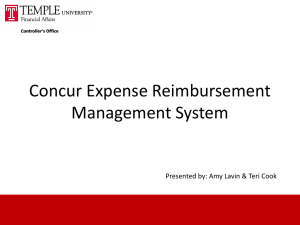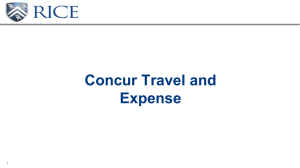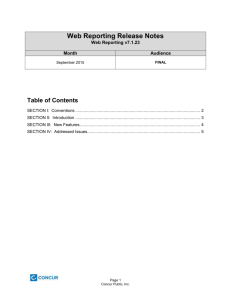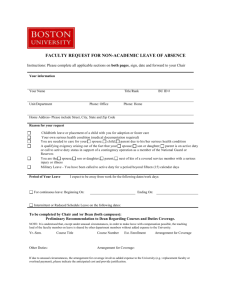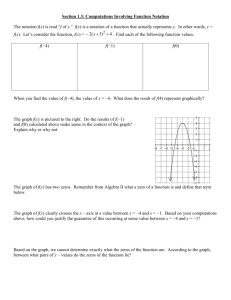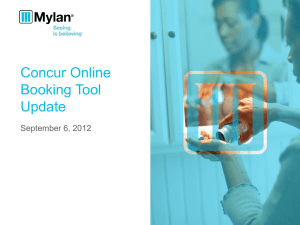Information requerements for Inception
advertisement
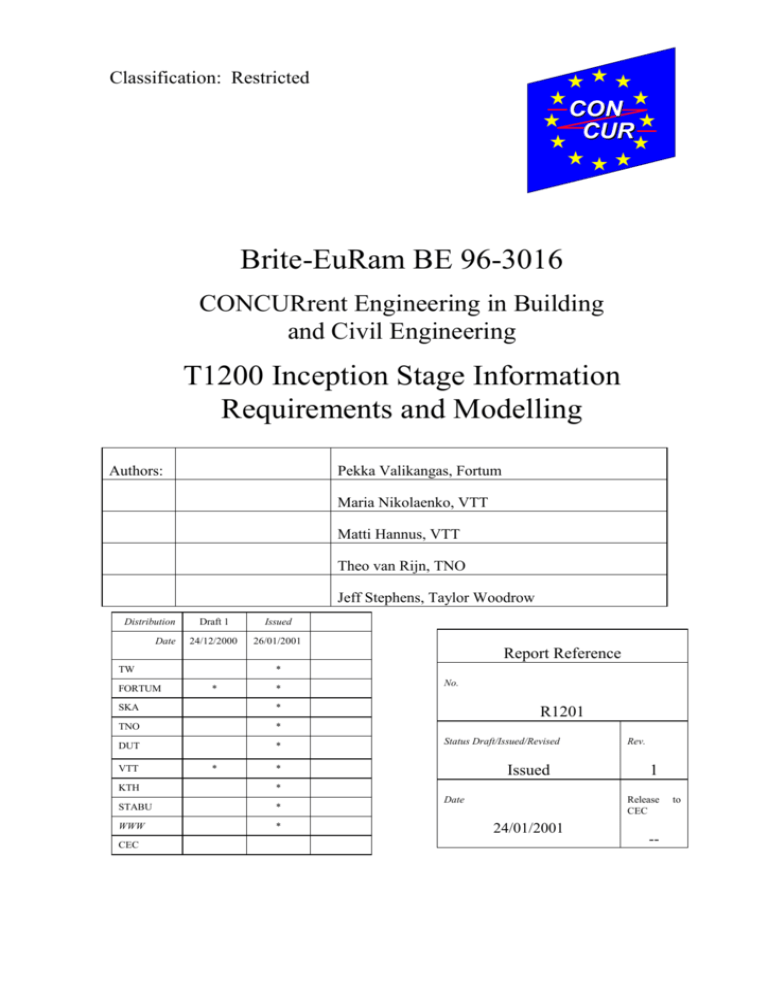
Classification: Restricted CON CUR Brite-EuRam BE 96-3016 CONCURrent Engineering in Building and Civil Engineering T1200 Inception Stage Information Requirements and Modelling Authors: Pekka Valikangas, Fortum Maria Nikolaenko, VTT Matti Hannus, VTT Theo van Rijn, TNO Jeff Stephens, Taylor Woodrow Distribution Date Draft 1 Issued 24/12/2000 26/01/2001 Report Reference TW FORTUM * * * SKA * TNO * DUT * VTT * R1201 Status Draft/Issued/Revised Issued * KTH * STABU * WWW * CEC No. Date Rev. 1 Release CEC 24/01/2001 -- to ii CONCUR R1201 This page is intentionally left blank CONCUR R1201 TABLE OF CONTENTS iii page 1. EXECUTIVE SUMMARY 1 2. INTRODUCTION, BACKGROUND AND SCOPE 1 3. 4. 5. 2.1 What is tendering 1 2.2 Objectives in tendering stage 2 2.3 Integrated modelling 3 INFORMATION MODELLING 5 3.1 Inception model 5 3.2 Design model 6 OBJECT OF INTEREST AND ONTOLOGY 7 4.1 CONCUR information ontology 7 4.2 CONCUR Meta Model 8 4.3 Functional unit - technical solution decomposition 9 4.4 Global model 9 ASPECTS AND ATTRIBUTES 9 5.1 Information aspects 5.2 Functions 10 5.3 Characteristics 11 5.4 Quantities 12 5.5 User actions and processes 12 5.6 Examples 5.6.1 Standby power installation 9 12 13 6. EXISTING MODELS 14 7. CONCLUSIONS AND RECOMMENDATIONS 14 8. REFERENCES 14 APPENDIX A, Inception Stage Information by Fortum Engineering Ltd 1 CONCUR R1201 1. Executive Summary “The end goal of the CONCUR project is the integration of industrial processes within the dayto-day operations of the industrial partners. incept incept design design realise realise downstream upstream Information store Figure 1.1 Two-way information exchange (left) implemented with an information store accessible by all throughout the project. [Frits Tolman et. al.] 2. Introduction, background and scope Work package 1 of CONCUR is addressing the way the industrial partners work and use necessary information. Doing process carries out work to that intent and information analyses in the industry partner companies. The results of the analyses were reported in a number of process models, one for each partner and a CONCUR Common Process Model describing the common processes found in the investigated organisations. The results were published in deliverables [R1101FI], [R1101SE], [R1101UK] and [R1102]. Task 1200 is giving direct results to T2200, which is reported in deliverable [R2201]. CONCUR is aiming to use and implement existing and emerging models [Frits Tolman et. al.], which are required to provide meaningful two-way information exchange in technical building projects. To realise two-way information exchange, which is needed for communication between the various disciplines present in the tendering process of a project, CONCUR needs common semantics and definitions. To enable deriving common semantics an integrated modelling approach was adopted. In addition the work package composed/assembled common information model from the explicit knowledge of the processes. The model describes the information needs in the tendering process. This report was written at the beginning stage of the CONCUR project (September 1998) and then reviewed at the end of it (January 2001). 2.1 What is tendering The result of CONCUR for the industrial partners is the implementation and use of integrated systems, spanning the early stages of the project life cycle: from inception to tender. This period of a project discusses business needs, tries different solutions and designs a selected one. Using integrated systems provides a consistent means of handling data and information accelerates the process and acts as a basis for further work in construction, operation and decommissioning. CONCUR R1201 2 Our analyses in CONCUR revealed that the tendering process also changes, similar to the way business changes. In conventional tendering for building projects an organisation received a detailed set of requirements and specifications for a facility, sometimes even containing detailed drawings. In CONCUR we leave the conventional notion of tendering based on a detailed description of the facility but we focus on the process ignoring a number of issues, like information ownership and authorship, differential or additional contractual obligations and changing responsibilities and liabilities. A definite end of the tendering process cannot be given, it is all up to the client and the contract, and depends on the succeeding process. For the purpose of CONCUR we let the tendering process end with the formal approval or dismissal of the client based on an accurate costing and detailed planning. A typical tendering process therefore ideally involves all disciplines that have any relationship to the facility and also elaborates on the complete life cycle of the facility. The consortium talking to the client is much more than a construction preparations group. It will act as a trusted partner to the client. 2.2 Objectives in tendering stage The main objective of the tendering stage is the specification of a facility in such a way that the client has a reasonable accurate price and has a sufficiently accurate description of the facility to be constructed and the delivery time of the facility, in accordance to set requirements. There are a number of bases to arrange the tendering process. As long as there is no contract to carry out work, a balance will exist between depth and detail, and effort. Despite the fact that decisions made early on might lead to large consequences in the remainder of the project. A tender team needs to take care that a minimal amount of waste is produced. As waste we might think of the effort made and results produced in case a project does not lead to an order. On the other hand the team needs to assure that effort and results produced are sufficient to win the order. That this leads to tension may come as no surprise. A hit rate of 25% means that 75% of the time and effort spend on tendering is waste and must be recovered in some other way. Reducing the effort in the 75% that is lost will directly result in better margins. The first test of the team will be to assess the viability of the project and judge it on its merits for client and other participants. It may well come out that a proposal for a facility might look promising, but lacks viability because of huge ground prices. During the assessment of viability and feasibility work is done in close co-operation with the client and other (potential) partners in the consortium to enable sound value engineering. The priority of the information gathering process is driven by the need to acquire more certainty and confidence. The first items to be refined, i.e. detailed, will be items that constitute risk or have high uncertainty. Building houses one would very much like to know whether the ground is heavily polluted which results in expensive cleansing operations, building a process plant one might care less. The team and the client together need to obtain confidence that a particular facility fulfils the business requirements of both parties and solves a problem to the client. Confidence will also be obtained or strengthened by producing a realistic construction programme with possible issues and bottlenecks clearly defined. The tendering process is one of many decisions: shall we build a high rise or shall we remain shallow, shall we use glass cladding or wood planes,.... What happens is that each action is CONCUR R1201 3 aimed at providing information for the next decision. The tendering process therefore is in essence an information production process. An information production process that takes some bits of information and refine and refine until enough is gathered for a sound decision. In fact each decision is aimed at determining viability, assessing and reducing risk, and eventually in calculating cost. As tendering is a refinement process this also holds for the requirements. In each refinement cycle more will be known and more detail will be presented about the performance requirements of the building or product under design. The CONCUR industrial Partners studied their tendering processes and a number of variations too. These were presented in the form of IDEF0 (ICOM) activity diagrams (figure 2.1, taken from [R1102].) that decompose (i.e. sub-divide) through about four levels of detail. As well as allowing the processes to be analysed and potentially better organised, the diagrams show the main sets of information that flow between the activities. It is this information facilitates communication between projects, disciplines and companies, and that characterise the integration of systems (manual and IT) needed to support communication. The exercise also first raised the issue of words, meaning and communication of concepts between partners. It was evident that partners easily misunderstood each another, particularly when discussing detail. Discussion was necessary to reduce “fuzziness” and increase precision person to person. Computer-to-Computer transfer of information must be unambiguous (i.e. precise) which requires careful definition of terms (see LexiCon later) and relationships (see data models later). Today an electronic model of the product that is collaboratively arrived at will facilitate the communication between disciplines and with the client. It also enables keeping consistent information about the facility. 2.3 Integrated modelling Integrated modelling addresses the various models not independently but includes the individual relations. It also looks at existing models and tries to position them in the CONCUR environment. Integrated models including processes, information semantics and information content are necessary to enable an integrated work practice sharing and using the same data. The most challenging issue has been to devise a way to capture, define, develop and maintain a consistent view of the business scope, business processes, information aspects, information objects and information flows. CONCUR needs two-way semantic information exchange about building projects. To do so CONCUR will use and implement existing models and concepts, based on a common terminology, common semantics and definitions. In CONCUR modelling has been done to identify activities, which are carried out during tendering by the industrial partners to capture work practice and information. We identify the (physical) objects of interest (ooi) which practitioners use in tendering. Objects of interest denote the way practitioners look at a facility during the tendering process. Different views can be introduced when a proper product tree is available. 4 CONCUR R1201 AUTHOR: Frits Tolman and Theo van Rijn DATE: 13/03/98 PROJECT: Common CONCUR Process Model REV: 3 USED AT: NOTES: 1 2 3 4 5 6 7 8 9 10 external C2 process constraints C3 Develop and Refine Concept of Technical Building technical building concept x site works Design and Refine Technical Building I1 READER DATE Compile, Submit and Decide on Tender is not decomposed. For CONCUR only the input for the Tendering process is relevant. If the tender is succesful the process continues, otherwise it stops. technical building as_designed Cost and Refine Technical Building global design technical building as_costed Compile, Submit and Decide on Tender A2 business process needs P. 5 (as relevant for the technical building) Design and Refine Tender Construction technical building Programme A3 as_planned A5 Detail, Erect technical and Operate building and Maintain O1 Technical Building comment NODE: A-02 TITLE: I2 raw materials construction products Conceive, Design, Plan and Erect Technical Building tender result A4 construction programme The main processes each transform the technical building into a subsequent States. "and Refine" implies required feed back loops including, e.g., from Plan back to Develop Concept. Note that the model focuses on the primary design process. Other important views for tendering, like planning, or cost are derived and not detailed. CONTEXT: comment process equipment building regulations, planning regulations, safety regulations, environmental regulations. A1 P. 4 C1 WORKING DRAFT RECOMMENDED PUBLICATION A6 comment The dotted process is outside the scope of CONCUR NUMBER: technical building as_realized in operation P. 3 Figure 2.1 Conceive, design, plan and erect technical building Although use is made of existing standard models, developed in STEP and IAI, composing a common information model is not possible without doing an amount of modelling. Purpose of the modelling activities is to identify and bridge the gap between practitioner’s models and how information is described with existing and proposed standards. Therefore one of the activities being done is to match the practitioner’s view of the world with existing and emerging standard models and derive a relation between how practitioners describe their world and existing models describe the world of building and construction. As stated in the Technical Annex information modelling will address various conventional project stages. Based on process analyses results and observations and conclusions there formulated, it was felt that individual modelling task results would not benefit to CONCUR. In stead an integrated modelling approach was proposed and adopted. This does not exclude the need to describe informational requirements for the processes defined along the traditional inception/client brief, feasibility study, concept design and tender stages approach. So information granularity gradually increases and ranges from the technical building to the information items needed to enable an accurate tender to be presented. This means that major cost items and major decisions are included, but no detail drawings (the conventional way of describing/defining a product) are included. 5 CONCUR R1201 Identification Identificationofofactivities, activities, information informationflows flowstotobe be supported and supported and supporting tools supporting tools Do inception Identification Identificationofofkey key objects objectsofofinterest, interest, their decomposition their decomposition and andsubtyping. subtyping. Identification Identificationofofrelevant relevant aspects aspectsofofthe theobjects objects Do design Do tender Identification Identificationofofthe the properties propertiesofofthe theobjects objects Do prj mgnt Object Objectontology ontology Object Asp1 Asp2 Information Informationplanning planning model modelas asaaroadmap roadmap totokey objects key objects Formal Formalproduct productdata data model(s) model(s)describing describingthe the detailed information detailed information requirements requirements Asp3 Object Property Description Candidate model Candidate model Candidate model xxx Figure 2.2 Overall scooping and capturing steps of information requirements into a formal product data model 3. Information Modelling Information structures are used to enable capturing the right information at the right time to provide proper back up of decisions being made and to register what bases decisions have been arrived at. 3.1 Inception model The inception model focuses on the information, which is acquired in the early phase of a project. Information is related to the business needs of the prospect, the business needs of the tendering consortium aimed at arriving at a feasibility of a project. The information then needed comprise the performance requirements a prospect wants the product to fulfil. Specifying performance requirements is a move from conventional projects where specifications might be based on very detailed drawings leaving out any design contribution from the tendered. An outline of a product, building or other solution is now given. Performance specifications might be as simple as “we need a hospital with 200 beds, 2 operating theatres and recovery rooms”, or “we need an office for 150 people with 2 management layers requiring 10 meeting rooms”. Figure 3.1 shows the story of the design process in the tendering phase (in FORTUM classification the Inception phase). Solid arrows represent data flows between different tasks (rounded boxes). Other arrows (dashed) represent data flow, in which the data is mainly generated during the design process and the inception data is not anymore noticeable. Fully coloured boxes are tasks, where the inception data is having considerable effect. Other boxes (coloured cross-hatched) represent tasks where the design work is mainly based on the design process itself. The main purpose of the CONCUR project is to specify the data flow (arrows) between different tasks. However tasks must be supported by development and/or configuration work in tasks T2200: “Configure Inception Software”, T2300: “Configure Project Management Software”, CONCUR R1201 6 T2400: “Configure Specification Software” so that the applications can take benefit from subsequent advanced data exchange (WP3: “Process and Application Integration”). Figure 3.1 Inception data flow in design process at tendering phase (Software under consideration during mid term review) 3.2 Design model The design model extends the outline, which has been described in the inception part of the process model. Since the design is aiming at resolving additional challenges and deciding on more detailed issues of the product and project development, it reflects the approach and work practice taken by practitioners. The traditional design model may be reshuffled to support modern and new ways of working and co-operation thereby providing the necessary information structures. Spatial requirements are based on the primary processes, which take place in the building. Processes and business functions are needed to enable spatial requirements to be derived. Building elements denote the physical constituent elements of a building. Two types of relations may exits between building elements: (1) composition or “has-a” relation and (2) specialisation or “is-a-type-of” relation. The former relation denotes the real breakdown of the building into elements. The second relation denotes each decision to be taken in the design process. Selecting a type-of foundation is an explicit design decision based on existing and present information, CONCUR R1201 7 such as soil condition, height of building, function of the building. Information to this purpose must therefore be present in the design model. The design model builds upon existing and emerging data standards. The approach adapted closely relates to the IAI IFC 1.5 development and similar standards such as STEP AP221 (“Functional data and their schematic representation for process plant“), AP225 (“Building elements using explicit shape representation), AP227 (“Plant Spatial Configuration“). For those areas which are not supported we have modeled additions to the IAI IFC 1.5 thereby taking into account the way the concepts of the complete model have been outlined. The following sections describe the concept which has been adopted by CONCUR to arrive at additional model elements which closed the gap between CONCUR and standards, hence between what is needed and what exists. 4. Object of interest and ontology Information is used to communicate. To enable electronic communication one need to identify the information used and needed to be communicated. During the process modelling activities some information modelling has already been done: globally identifying what information is needed and what information is produced by activities. Practitioners have their own way of communication. They certainly don't exchange information in terms of information models but they speak about their own objects: their objects of interest (OOIs). During discussions with practitioners a set of OOIs has been identified (See appendix A). They denote the terms with which they communicate in the early stages of a project. Built Objects are similar to the Objects of Interest. Looking at the OOIs a structuring has been applied. The structuring follows the thinking process and information expansion and detailing which takes place in the tendering process. Views associated with the disciplines involved in building and construction lead to different information entities. Information is associated with a functional system or unit, e.g., structural system, electrical system, spatial system. Each system has certain requirements to be derived from the use of the total product and the client perception. The functional units noted can be matched and implemented by technical solutions. 4.1 CONCUR information ontology CONCUR set the top level of a product tree, based on discussions with practitioners. A few levels of detail are added. The product tree will evolve into a complete product model. Modelling however is not the focus of CONCUR. But with insufficient existing material and standards for the tendering process, additional modelling work is done. CONCUR uses as many existing information models as possible. Therefore the information modelling activities are aimed at identifying the entities involved, i.e. what determines the product tree, and selecting from what existing model they might be taken. In a way that CONCURS will be able to compose its information model and use tools available for and associated with the models, e.g. AP221, IAA IFC 1.5, and AP225. Figure 4.1 shows the top level of the objects of interest, which have been agreed by the practitioners. The complete EXPRESS-G diagram also shows relations to IAI IFC 1.5 elements. 8 CONCUR R1201 Superstructure containsSystems S[1:?] ExternalEnvelope System StructuralSystem RoofSystem (ABS) System InternalSpace System InternalSpace DividingSystem ExternalSpace System ExternalSpace DividingSystem 9,1 BuildingServicesSystem containsFacadeAssembliesS[1:?] containsSegments S[1:?] containsDividers S[1:?]containsGroups S[1:?]containsDividers S[1:?] containsStructuralAssembliesS[1:?] 4,1 StructuralSubAssembly 7,1 FacadeSubAssembly 2,1 RoofSegment 8,1 InternalDivider 3,1 ExternalSpaceGroup 6,1 ExternalDivider containsInterconnections S[1:?] containsGroups S[1:?] 5,1 InternalSpaceGroup 5,2 Interconnection Figure 4.1: CONCUR High level objects of interests 4.2 CONCUR Meta Model Adding more structure to the CONCUR OOIs several steps forward have been tried. All steps were aimed to restrict information modelling to the bare minimum and rely on existing and emerging standard models. A limited number of relevant relations between OOIs can be identified. Besides "part-of" for decomposition, "is-a" for subtypes, "connects" for connectivity is added and "role" to denote specific views and uses of objects. From these considerations the following core of meta-model was derived. Subtype unique Identification Part-of CONCUR_ Data_Item Connects CONCUR_ Object relates S[2:?] CONCUR_ Relation Figure 4.2: Core of a CONCUR meta model [Frits Tolman et. al.] Role-of 9 CONCUR R1201 4.3 Functional unit - technical solution decomposition The General Architectural Reference Model described in [Frits Tolman et. al.] states that functional units specify facilities or functions that can be provided by a technical solution. Each occurrence of FU-TS therefore denotes a design decision: selecting a specific technical solution. 4.4 Global model Because of practical reasons of the CONCUR project the information was divided into a restricted number of different areas of interest. The areas combine the view and discipline of various specific topics that are investigated in the tender stage. The principle is shown in Fig. 4.3. First of all the approach was to derive performance specifications based on the spatial needs of a prospect. Second there was the translation of spaces into more substantial building elements. Third the building services were determined and their capacities noted. Fourth the types of finishes of building elements and spaces were collected. Each collection step includes resources required, work methods needed and cost derived. STABU CI/SfB UNICLASS KKS A Project standard Classification System Project Specific Reference System Office Ward Turbine Hall Services void Floor 6 Zone A Room 9 East Wing Function Location Conceptual Space X,Y,Z IFC/STEP Position contains Geometry Volume Area Capacity Figure 4.3: Global model of project information 5. Aspects and attributes 5.1 Information aspects We use aspects to identify information needs in our discussions with practitioners. An aspect of an object describes (a collection of) distinct properties of an object. An aspect of an object may be represented in various ways by a collection of attributes. In other words, an aspect of an object is a grouping of objects attributes belonging somehow together and which are interesting enough to record information about. The role of aspects is to enable the capturing of relevant information grouped together, which addresses a specific topic in relation to the object of interest. CONCUR R1201 10 Definition of the relevant aspects of interest of the objects is one step in the overall modelling process, and it serves the scooping of the modelling by providing some hints on what type of properties of the objects should be included in the product data model. The following addresses several aspects we may be interested in. The definitive list is under construction and will be reviewed shortly. The main aspects of information are derived from the business process, which specifies that the product cost and value to the client are the main outputs of the process. These are critical aspects for a project developer. The value is derived from the product’s specification and availability e.g. delivery time. The costs are derived from the size and terms of investment involved and the maintenance and operating costs. Both value and cost are thus dependent on the product specifications, on the production costs and the production time. Thus, the product description, the production cost and production time, are the basic information outputs needed. Looking at cost one is only interested in quantities and unit cost to be able to calculate a price for the facility. This is true at any point in time in a project, irrespective of the level of detail of available information. The level of detail leads to a change in type of quantities and unit cost. Finishes are not priced individually at first but are part of the square meter price for office space. The actual cost estimates associated with the product and its realisation will be determined during the process. Deriving more accurate cost figures does not follow from increased knowledge. The set cost boundaries work as a balance. They imply that an increase in e.g. design complexity, which in turn will lead to a change in price, is followed by a balancing act: choosing a lesser price of material or supplier to decrease the total cost. Several aspects, besides time and cost, can be derived from looking at a building from the associated viewpoints and in accordance to set requirements, e.g.: legislation, aesthetics, strength, safety, comfort, buildability, and environmental impact. In the end the attributes contain the actual information values. Combining and grouping attributes provides the reader with the actual information he or she seeks. Aspects are topics like strength and stiffness, safety, economics, etc. They can be viewed as denoting categories of attributes, i.e. the actual measurable information. What aspects are relevant to CONCUR depends on the importance of the aspect in the tendering process. Important aspects relate to the interaction between various disciplines involved in specifying, designing and constructing a technical building. Each partners have their own main interest focused in their role in the CONCUR demonstration. Appendix A Shows aspects of inception information from Fortum Engineering. The attributes are limited for the moment to the following categories: functions, characteristics and quantities; these are briefly discussed below. Another category, which remains to be done, is about functions. 5.2 Functions Functions describe the (possible) involvement of an object in its environment. A function specifies what contribution will be expected from the object, which role it has to play, what kind CONCUR R1201 11 of task it has to fulfil. A function in itself cannot be quantified, and is therefore always descriptive. Functions are organised in three levels: function categories, functions and detailed functions. This hierarchy is only meant to provide some structure. The detailed functions, on the lowest level, may actually occur in specifications. Functions are identified by name only; the function content has to be added. In project specifications functions will be placed in a context: the environment in which they operate. The function content is on the one hand related to the performing object, and on the other to the user action or process in which it is involved. For example, one of the functions is Electricity supply. This function could be related to a building (the building needs electricity), as well as to a single room in that building (the room has electricity outlets), or to a whole complex or plant (e.g. by means of a power station). Also, the function could be specified for the main energy supply, as well as for a standby supply. Thus, the function Electricity supply has to be related to the object building, or room, or plant, as well as to the process of either main or secondary energy supply. Another example, which shows the dependency of a user activity more clearly, is the space providing functions. If the space has to accommodate a user action, then the user action actually provides the space requirements, i.e. the consumption of space. A power plant as a whole has space requirements, and so has the user activity of sitting. A space could also be required to accommodate other objects, e.g. the opening in a wall object would be a space (from the wall's point of view) to accommodate a window. Also this wall could embody pipelines, outlets and other stuff, which (again from the wall's point of view) would be reserved space. The specification of a function may imply other functions, e.g. an accommodation for sports includes spaces to accommodate sitting. 5.3 Characteristics Characteristics describe the object itself and its behaviour. Basically a characteristic can be quantified, which means that a characteristic should be related to a quantity (see below). The list of characteristics is organized in categories. So far, there are four categories: Composition, Load/Input/Output, Performance and Property. A characteristic may occur in several categories, so categories should not be interpreted as a hierarchy, but more as aspects. Composition not only comprises the physical structure, but also logical ones, like 'Signal-to-noise ratio' and 'Relative humidity'. In general, composition is a set of references to other objects. Load/Input/Output are characteristics that may come from, or sent to the environment. This context should be made explicit in the specification. For example a Floor has a Load to carry, this Load will then be transferred to other objects in turn. As another example, a luminary needs electricity as input, which it will transfer into light as an output. In this case both input and output are distinct, relevant characteristics. Performance is interpreted here as a (required) capability, which would be needed for the fulfilment of a function (see above). A performance is triggered by its function: a luminary is capable of providing light, but it only does so when switched on. A Property is a characteristic 'proper' to the object. The set of properties is responsible for the performance (and thus for the functionality) of the object. A number of properties could be interpreted as performance as well; in this case they are listed both as a property and a CONCUR R1201 12 performance. For example an object could be 'damp proof', which would be a property, but a certain level of 'dampproofness' may also be regarded as a required performance. Characteristics are for a large part extracted from the Glossary of building and civil engineering terms (BSI). Other characteristics come from the STABU system, (hopefully correctly) translated into English. 5.4 Quantities Quantities are basically based on the SI units. They are maintained in STABU system currently in Dutch and to be replaced by the international version in due time. A number of quantity types are needed in addition to SI; most of these are basically the same as the SI quantity, but more specific. Quantity types are used to give values to characteristics. 5.5 User actions and processes For Built Objects, user actions and processes are their 'reason of existence'. Generally, user actions and processes require Space (for which the accommodation function is introduced above), which space requirement is then translated into Built Objects. User actions and processes are anticipated to quantify the related space requirements. The list is not yet ready however. It is end users interest after CONCUR project to continue to list basic (human) activities, like active or passive sitting, standing, lying down, etc., as well as complex actions and processes like conferencing, sports, and producing electrical power in a power plant. 5.6 Example First of all, it should be clear that a specification could be given for Built Objects at any level of decomposition. So, a specification could specify a Power Plant as a whole, or a Turbine Building as a part of that plant, or a Wall as part of that building, or a Window embodied in that wall, or a Lintel as part of the wall. However, on whatever level the object may be, it will always be specified on that level only, with references to an environment (as the higher level) and possibly, in the other direction, to the first level of decomposition. So, in order to find the specification of the Lintel, starting at the level of Power Plant, you have to traverse the tree from level to level: Power Plant -> Building -> Wall -> Lintel. A specification has two parts: the first part describing the 'abstract' object in its environment (the Functional Concept, or FC) and an optional second part (the Solution Concept, or SC) describing the object's composition and properties. For one FC there are normally a number of possible SCs, but ultimately in a project only one of these options will be chosen, so at the end a single FC relates to a single SC. For example specifying its performance, and some shape outlines could specify a Floor as an FC. A number of SCs could fit that specification: In site cast concrete floors, prefabricated concrete slab floors, timber floors, etc. Each SC will have its own specification, with a set of references to the components and a set of characteristics. Ultimately, one of these solutions will be chosen, in which case the specifications of both types will be joined. CONCUR R1201 13 It should be noted, however, that there does not always exist a one-to-many mapping between FCs and SCs. Frequently a number of SCs may provide the required functionalities of several FCs ( many-to-many relationship). Starting at the level of Power Plant, the FC specification of it would generally specify the required output with regard to its environment. The function of the Power Plant would be: Electricity supply. This function would then be quantified into a required output of, say, ´100 MWe + 30 MWt´. The output is in the overview of characteristics listed as 'Electrical power + district heat power'. The SI quantity would be 'watt', so the MWe and MWt -unit has to be added as an alternative quantity. In the case of the Power Plant 'Electrical and district heat power' have to be generated, so 'Electricity and district heat generation' would be an implied function of the Power Plant. There are a number of SCs for the Power Plant FC, amongst which are: a hydroelectric power plant, a nuclear power plant and power plants using fossil fuel. Depending of the choice we would then be able to design and specify the major parts of such a power plant. These parts would then stand for a new series of FCs. At some level of decomposition a Turbine building will be specified as an FC. Also we may encounter at a certain level a 'Standby power installation'. This installation might be necessary to keep parts of the Power Plant running when the main internal power supply would fail. The FC specification of this installation could be something like this (note that not all characteristics are yet in the list): 5.6.1 Standby power installation Primary power (input) – Nominal voltage (V): 400/230 – Maximum voltage tolerance (%): +6, -10 – Frequency (Hz): 50 – Maximum frequency tolerance (%): +1, -1 – Supply system: TN-C Load conditions (output) – Nominal voltage (V): 400/230 – Maximum voltage tolerance (%): +6, -10 – Frequency (Hz): 50 – Maximum frequency tolerance (%): +1, -1 – Supply system: TN-C-S – Capacity load (kVA): 100 – Asymmetrical load (%): < 2 – Power factor (cos.fi): 0,8 – Short-circuit capacity (MVA): 100 Operation – Automatic switch-over to emergency operation after a decrease of voltage (%): > 10 – Change-over time (s): < 15 – Switch back to normal operation: automatic – Maximum switch-over time (h): > 100 Parallel operation – Automatic synchronisation – Lag time (min): > 15 Modes – Standby – Emergency – Bypass CONCUR R1201 14 Control – Operation – Failure Control interface – RS 232 Reliability – MTBF (h): > 150.000 6. Existing models CONCUR project has selected IAI´s IFC 1.5 model as a common tool for data repository of project. The IFC 1.5 schema and Fortum Engineering´s KKS classification system is a basis for inception data structure – see Appendix A. 7. Conclusions and Recommendations These conclusions are made in accordance with [R2201], Configure Inception Software. The work on this task: “Inception Stage Information Requirements and Modelling” proved, that international standards are ready enough for the goals presented in CONCUR project. It was possible to use directly IFC specifications as a basis of product models and as a data exchange protocol between different applications, which CONCUR partners have. Work in task 2200 proved that common CAE tools are still not ready to be implemented directly to support IFC syntax of product models. It was also found to be useful, if software could adapt better to different IFC versions by reading schemas. 8. References [Frits Tolman et. al.], TOLMAN, F., OZSARIYILDIZ, S., VAN RIJN, T. & WOESTENENK, K. 1998. Concur: integrated processes, software, models and data. CONCURrent Engineering in Building and Civil Engineering, Brite-EuRam BE96-3016, 02/98 [R1101FI], SERÉN, K.-J. & VÄLIKANGAS, P. 1997. Process model for industrial partner IVO Power Engineering Ltd. CONCURrent Engineering in Building and Civil Engineering, Brite-EuRam BE96-3016, R1101FI, 30/06/97 [R1101SE], HOGÅRD, P., BALATON, E. & JÄGBECK, A. 2000. Process models for industrial partners Inception to Tender Process – AS IS (Skanska). CONCURrent Engineering in Building and Civil Engineering, Brite-EuRam BE96-3016, R1101SE, 01/03/00 [R1101UK] VAN RIJN, T. & STORER, G. 1997. Process model for industrial partner Taylor Woodrow Inc. CONCURrent Engineering in Building and Civil Engineering, Brite-EuRam BE96-3016, R1101UK, 25/08/97 [R1102] TOLMAN, F., VAN RIJN, T. & BÖHMS M. 1998. Common process model. CONCURrent Engineering in Building and Civil Engineering, Brite-EuRam BE96-3016, R1102, 23/11/99 [R2201] VÄLIKANGAS, P. 1999-2001. Configure inception software. CONCURrent Engineering in Building and Civil Engineering, Brite-EuRam BE96-3016, R2201, 24/01/01
